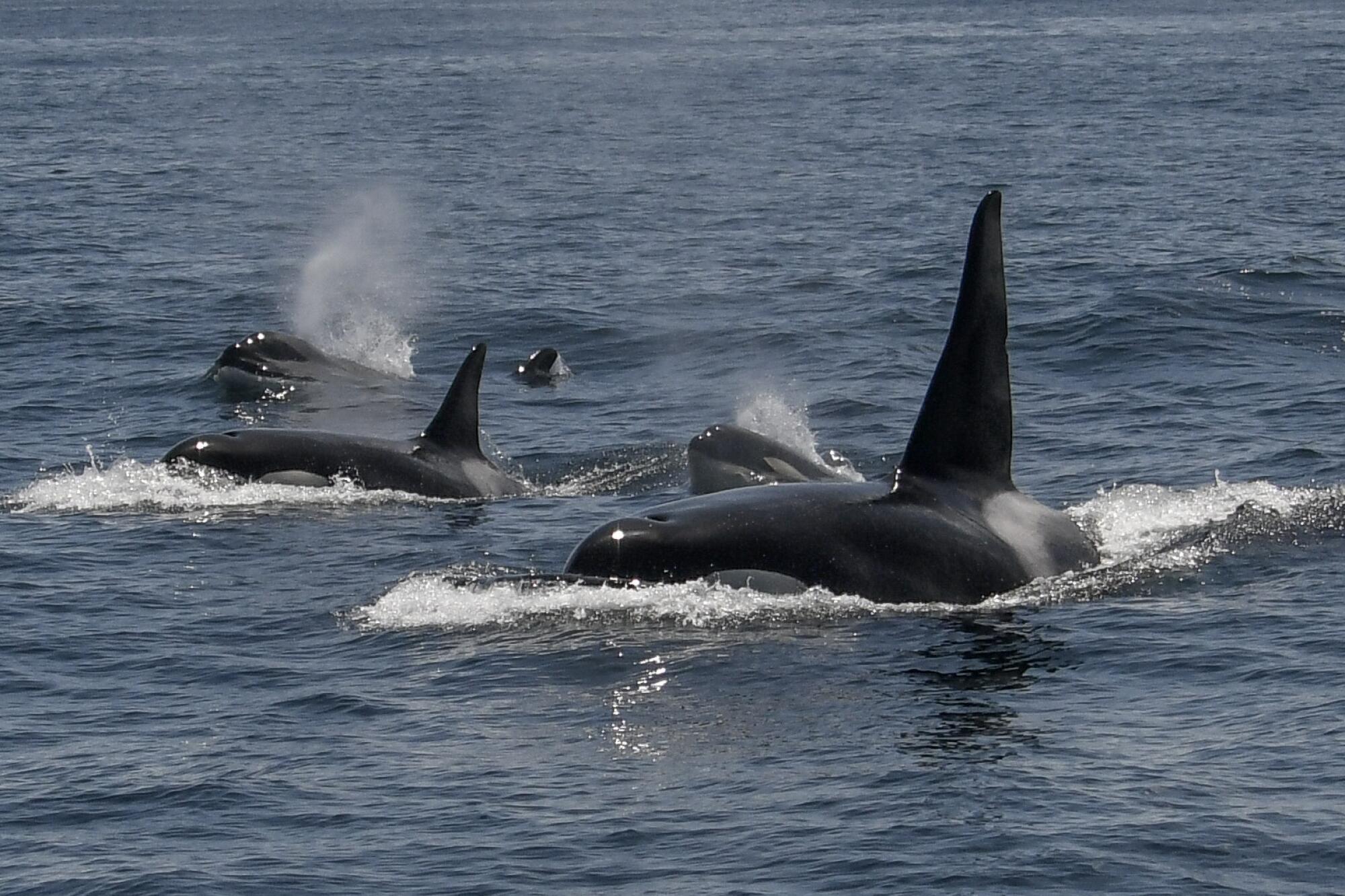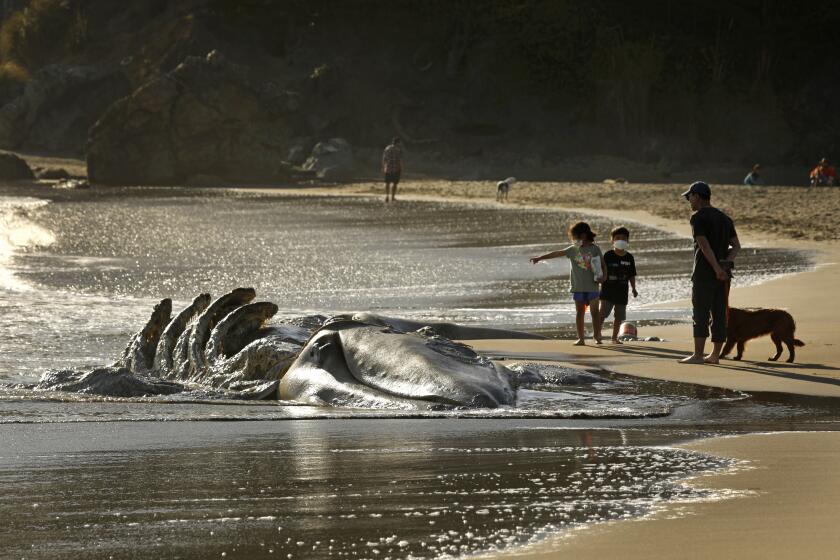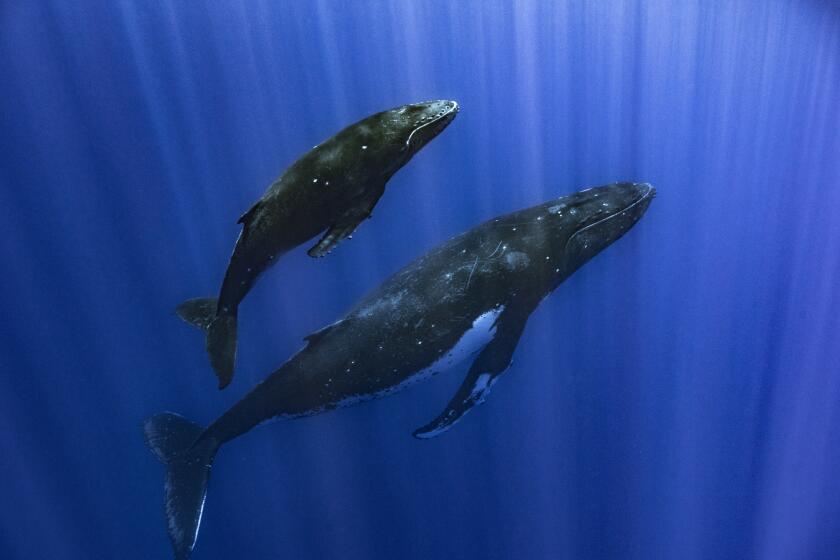
More than 150 years ago, a San Francisco whaler noticed something about killer whales that scientists may be about to formally recognize — at least in name.
Charles Melville Scammon submitted a manuscript to the Smithsonian in 1869 describing two species of killer whales inhabiting West Coast waters.
Now a new paper published in Royal Society Open Science uses genetic, behavioral, morphological and acoustic data to argue that the orcas in the North Pacific known as residents and transients are different enough to be distinct species. They propose using the same scientific names Scammon is believed to have coined in the 19th century.
Aggressive and impactful reporting on climate change, the environment, health and science.
Killer whales, found in all oceans, are currently considered one global species. The new proposed species would mark the first split of the ferocious apex predators, which, if approved, could have significant conservation and scientific implications — in addition to furthering a decades-long quest to properly classify the whales.
The two proposed species may look indistinguishable to the untrained eye, but there are subtle differences in their fins and markings — and many more unseen ones. They don’t speak the same “language” or nosh on the same food. And they have no interest in hanging out with one another, despite often dwelling in the same waters. Most significantly, researchers say, their DNA shows clear distinction.
Transients — also called Bigg’s killer whales — hunt seals and other marine mammals in small packs in expansive waters stretching from Southern California to the Arctic Circle. And they’re not very chatty while they sneak up on prey — they need to maintain stealth. They sport pointy, triangle-shaped dorsal fins with a solid white “saddle patch” behind it.
Residents, meanwhile, stick to fish — primarily Chinook salmon. They love to gab and hang out with the family. In fact, most offspring stay with their mothers their entire lives. Because fish don’t hear very well, they’re free to chatter as they chow down. Residents hew closer to coastlines, from Central California to southeast Alaska, where salmon congregate. Their fins tend to curve back toward the tail and intrusions of black sometimes extend into their saddle patches.
A third type of killer whale roams the Pacific, but less is known about it; these offshore whales live farther out and prey on sharks and other large fish. A recent study found evidence of another, previously unknown group in the open ocean.
Researchers suspect that starvation may have killed half off all gray whales off the Pacific Coast of North America. What happened to their food source?
Taxonomy, the scientific discipline of naming and classifying animals, is how we break down critters into species. It’s an intellectual exercise that has real-world consequences.
“We’re facing a global conservation crisis, losing species that we don’t even know exist,” said Phillip Morin, the new study’s lead author and a marine mammal geneticist at the National Oceanic and Atmospheric Administration’s Southwest Fisheries Science Center.
If you think of killer whales as one species — a big pie — then killing some of them off here might not be a cause for concern, Morin said. But if you start parsing out species and subspecies — slices of the pie — then it’s suddenly possible to lose a unique, irreplaceable group.
A portion of the fish-eating resident killer whales — known as Southern Residents — is already listed as endangered in the U.S. and Canada. Salmon depletion from overfishing and habitat destruction has starved them, and only about 75 are left now. But if they’re designated as part of a species, the International Union for Conservation of Nature will assess them (and transients) separately.
Study co-author Thomas Jefferson, a marine mammal biologist, also with NOAA’s Southwest Fisheries Science Center in La Jolla, believes the residents would probably be categorized on the conservation union’s Red List as threatened or endangered, possibly even critically endangered.
About 20 years ago, when Morin first began his foray into the world of marine mammal genetics, he said there was agreement that the taxonomy of cetaceans — which includes whales, dolphins and porpoises — was “really poor.”
Classification of land animals is often done by measuring bones, but water dwellers are hard to collect and store. Researchers don’t have extensive collections of whale skulls in museums from around the world, and it isn’t necessarily ethical to acquire them. They needed other tools — such as better genetics, drone recordings and satellite tagging — which didn’t exist yet.
“The genetics has now finally come to the point where we can do this on a broad scale and get the kind of resolution and information that we didn’t have,” Morin said.
Over two decades, researchers went from analyzing thousands to billions of base pairs of DNA from individual killer whales. The enhanced detail has allowed scientists to “look back through time,” Morin said, and answer questions about which killer whale populations are closely related — or not — and when differences emerged.
Based on their genetic analyses, Morin and his team estimate that transients diverged from other orcas between 200,000 and 300,000 years ago, while residents began to split off about 100,000 years ago.
Only a small tissue sample is needed to analyze killer whale DNA to tell a big genetic story.
“We can actually go out with a crossbow and collect a little teeny bit of tissue from a living whale — just shoot a little dart at it and collect a little bit of skin,” Jefferson said.
Of course, scientists in the 19th century dedicated to describing and categorizing whales didn’t have access to this cutting-edge technology.
Virtually nothing was known about marine mammals of the West Coast of North America in the mid-1800s, when Charles Melville Scammon, the whaler, began meticulously documenting and measuring cetaceans, Jefferson said. (Scammon bears no relation to Herman Melville, author of whale-centric “Moby Dick.”)
A long history of human-on-sea-creature cruelty — whaling and whales in captivity — on the Palos Verdes Peninsula preceded this summer of orca, otter and dolphin attacks.
When Scammon’s paper from 1869 describing a variety of cetaceans of the West Coast, including orcas, made it to the Smithsonian, he had “every reason to believe that his article would be well received,” according to “Beyond the Lagoon,” a biography of the seaman. He knew things no other zoologist did because of his proximity to the whales and keen eye.
In a paper penned three years later, Scammon paints a vivid picture of killer whales, from their “beautifully smooth and glossy skin” to their “somewhat military aspect,” even including drawings. He recounts a gruesome attack, seen in “Lower California,” by a trio of killer whales on a gray whale and her baby.
The orcas assaulted the pair for at least an hour, eventually killing the younger whale while exhausting the mother. “As soon as their prize had settled to the bottom, the trio band descended, bringing up large pieces of flesh in their mouths, which they devoured after coming to the surface,” Scammon wrote. “While gorging themselves in this wise, the old whale made her escape, leaving a track of gory water behind.”
What Scammon didn’t know was that his earlier manuscript would fall into the hands of Edward Drinker Cope, a naturalist who had a reputation for being overly ambitious and warring with colleagues for credit.
Cope, secretary of the Academy of Natural Sciences of Philadelphia, slapped his own introduction on the paper with descriptions and Latin names of the orcas inhabiting the Northern Pacific.
Because of rules governing the scientific naming of animals, Cope would forever be credited with the names believed to have been chosen by Scammon. Nevermind that Cope probably never saw a living killer whale.
The paper also misidentified Scammon and gave him little credit. When the whaler saw it, he was furious, according to the biography.
“It‘s a really, really strange and very weird and dramatic episode in the history of marine mammal biology, how these names came about,” Jefferson said.
Many of Scammon’s observations turned out to be erroneous. Often he logged differences between male and female killer whales rather than differences between species, said Michael Milstein, a spokesperson for NOAA. But his inquiry set the stage for more rigorous research to come.
Morin and his research team propose using the same Latin names from more than a century ago for the species they identified in their recent study.
The researchers call transients Orcinus rectipinnus, noting that, in Latin, “recti means right or upright, and pinna means fin, feather, or wing, most likely referring to the tall erect dorsal fin of males.”
Residents, meanwhile, are labeled Orcinus ater. Ater means black or dark, according to the study, “which probably refers to the largely black color of this species.”
All killer whales are currently classified as Orcinus orca, a macabre nod to their vicious reputation. Some say Orcinus means “of the kingdom of the dead,” a reference to Orcus, a Roman god of the underworld.
There are also common, or informal names, to consider.
The researchers suggest sticking with “Bigg’s” for transients, honoring Michael Bigg, the father of modern-day orca research.
The team plans to consult tribes who have a connection to the resident whales, including the Lummi Nation and Tulalip tribes of the Northwest, before settling on a common name, according to Milstein.
“They decided not to try to rush it to match the paper, but to take the time to make sure it is done in a way that everyone understands and believes in,” Milstein said.
Whales sing loud enough that the sound travels through the ocean, and scientists think it’s because they have specialized voice boxes.
John Durban, an associate professor with Oregon State University’s Marine Mammal Institute and co-author of the new study, said he supports using the name “Blackfish,” which is used by some tribes in the Pacific Northwest.
Complex rules govern the discipline of taxonomy, and typically a specimen must be designated as a reference point when it’s first named.
However, the original specimens studied by Scammon were destroyed or disappeared. According to Jefferson, one at the California Academy of Sciences in San Francisco was wiped out by the historic 1906 earthquake and subsequent fire. Another, believed to have been in Scammon’s personal possession, can’t be found.
So the researchers found stand-ins at the Smithsonian.
Whether the broader community of marine mammal biologists will accept the researchers’ findings — and adopt Scammon’s and Cope’s names — will soon be determined.
The proposal is slated to go before a committee from the Society for Marine Mammalogy, which will vote in a few months on whether to greenlight designation of the species. Jefferson and another author of the new study sit on the committee and will recuse themselves from the vote.
Even today, Scammon has to contend with detractors.
Robert Pitman, a marine ecologist with Oregon State University who was not involved in the study, isn’t “entirely happy” with the names put forth.
The names were conceived “before science, by and large, especially biological science, had any rigor,” Pitman said. “And then the descriptions that [Scammon] puts with those names are just so vague. I’m kind of doubtful that those names will stand.”
Names aside, he expects most marine mammalogists will be on board with the proposed species; many have suspected species-level differences among the well-studied whales of the Pacific Northwest. He said the case for splitting off the mammal-eating transients is particularly strong.
The newly identified species are believed to be harbingers of more to come.
Pitman, who has studied killer whales in Antarctica for over 10 years, said there’s a similar divide between mammal- and fish-eating killer whales in those waters.
There are five identified types, and Pitman thinks at least one will turn out to be a different species. Some look dramatically different.
“And it’ll probably be easier now that somebody’s already made the first step in saying, ‘There’s more than one species out there.’”
Concerns about the endangered desert pupfish delay Colorado River conservation plans in Imperial Valley












